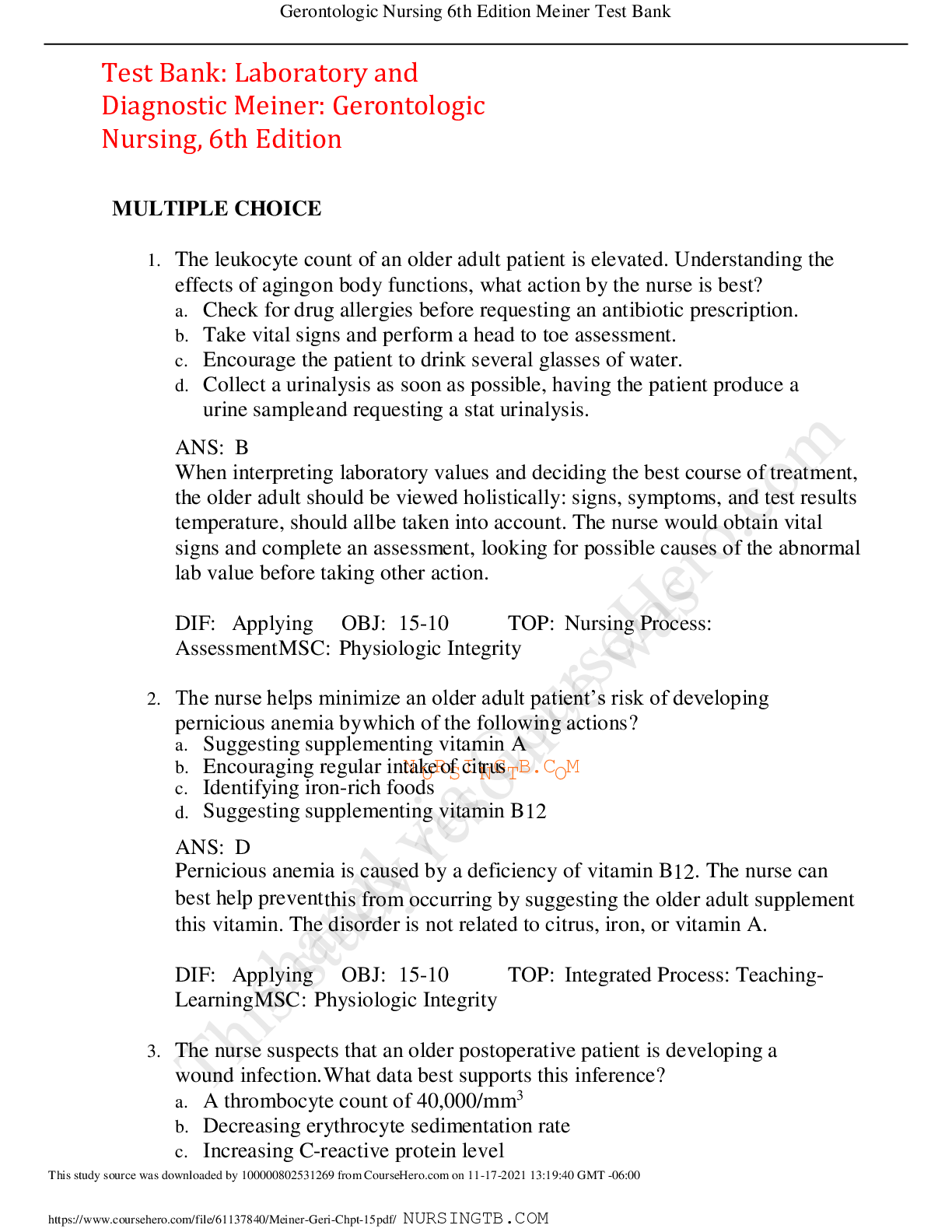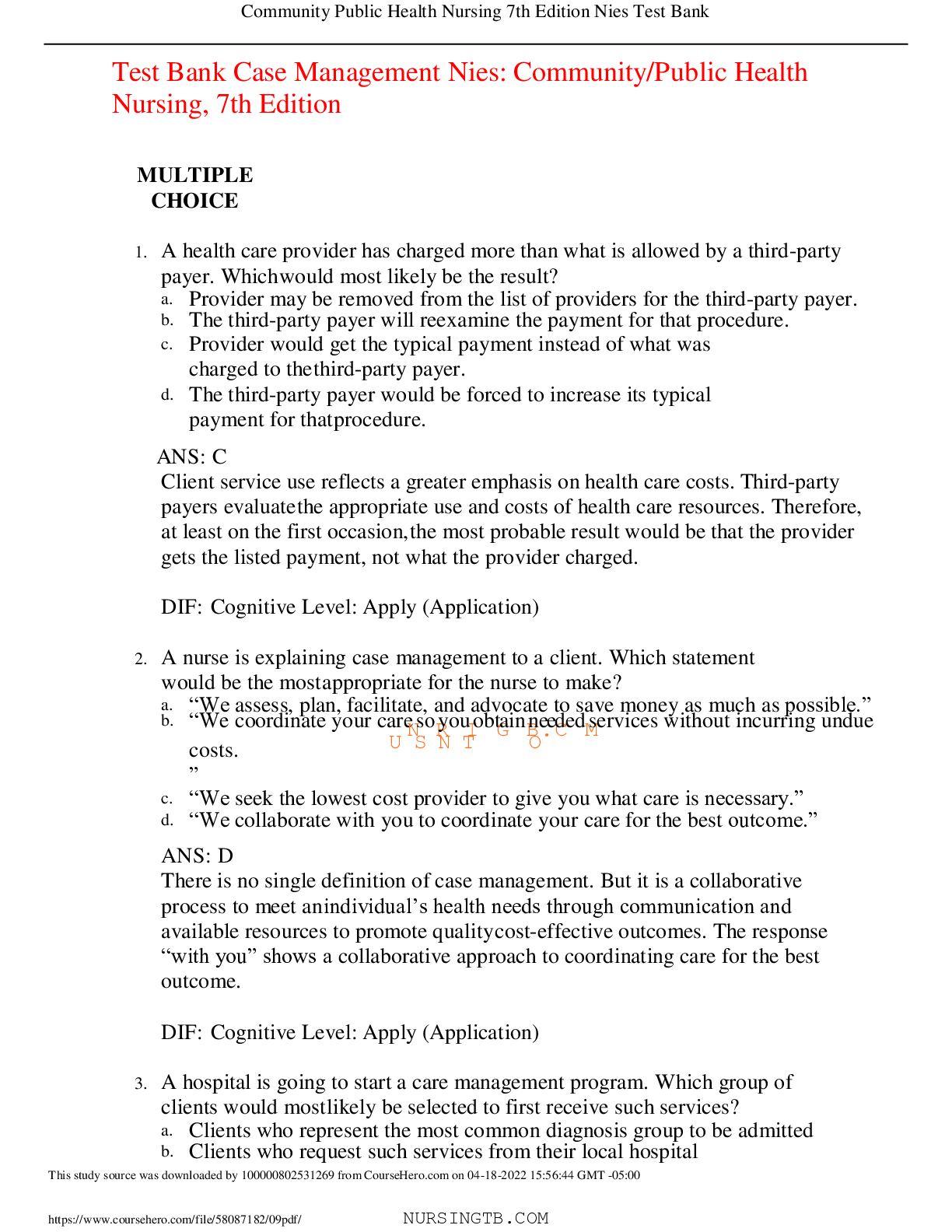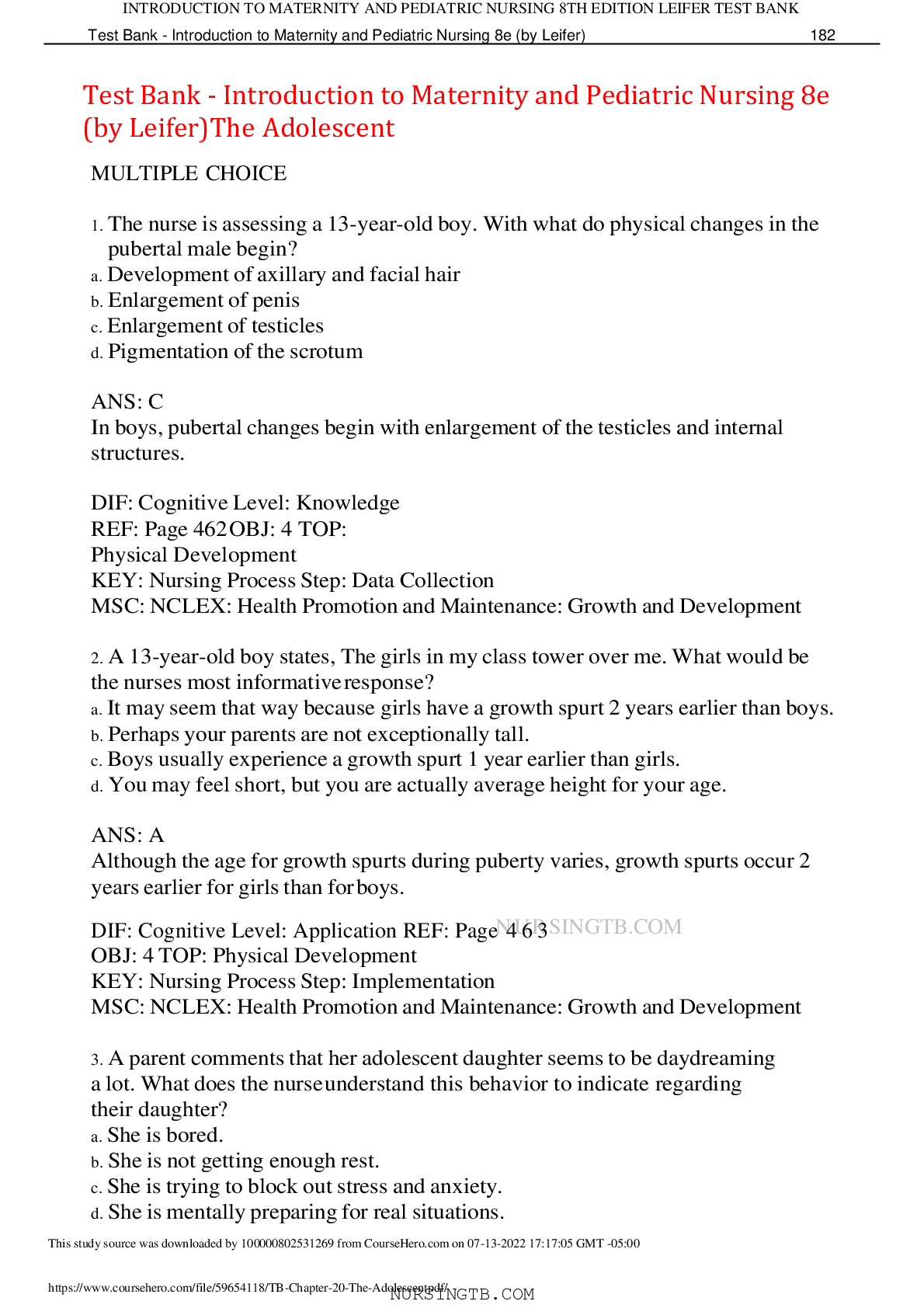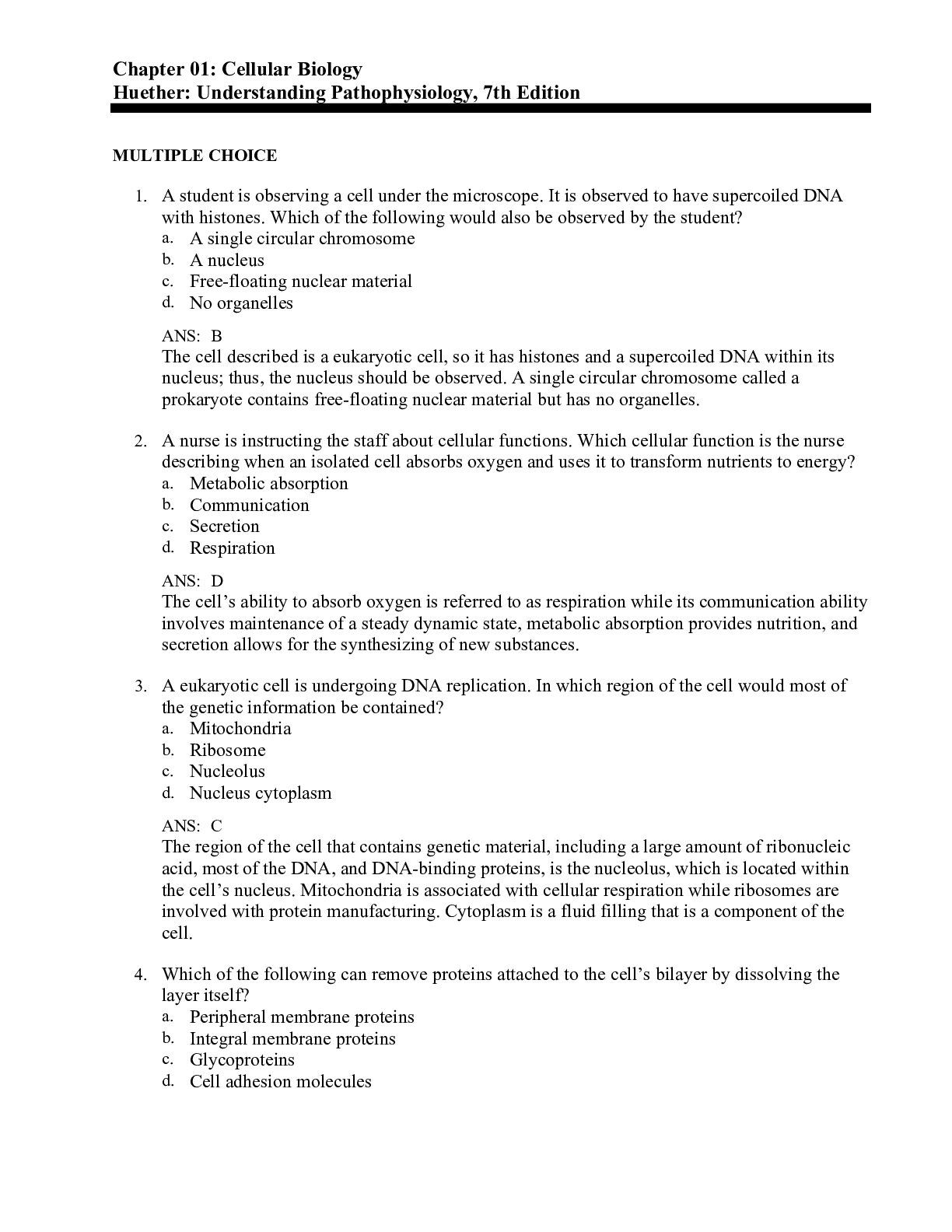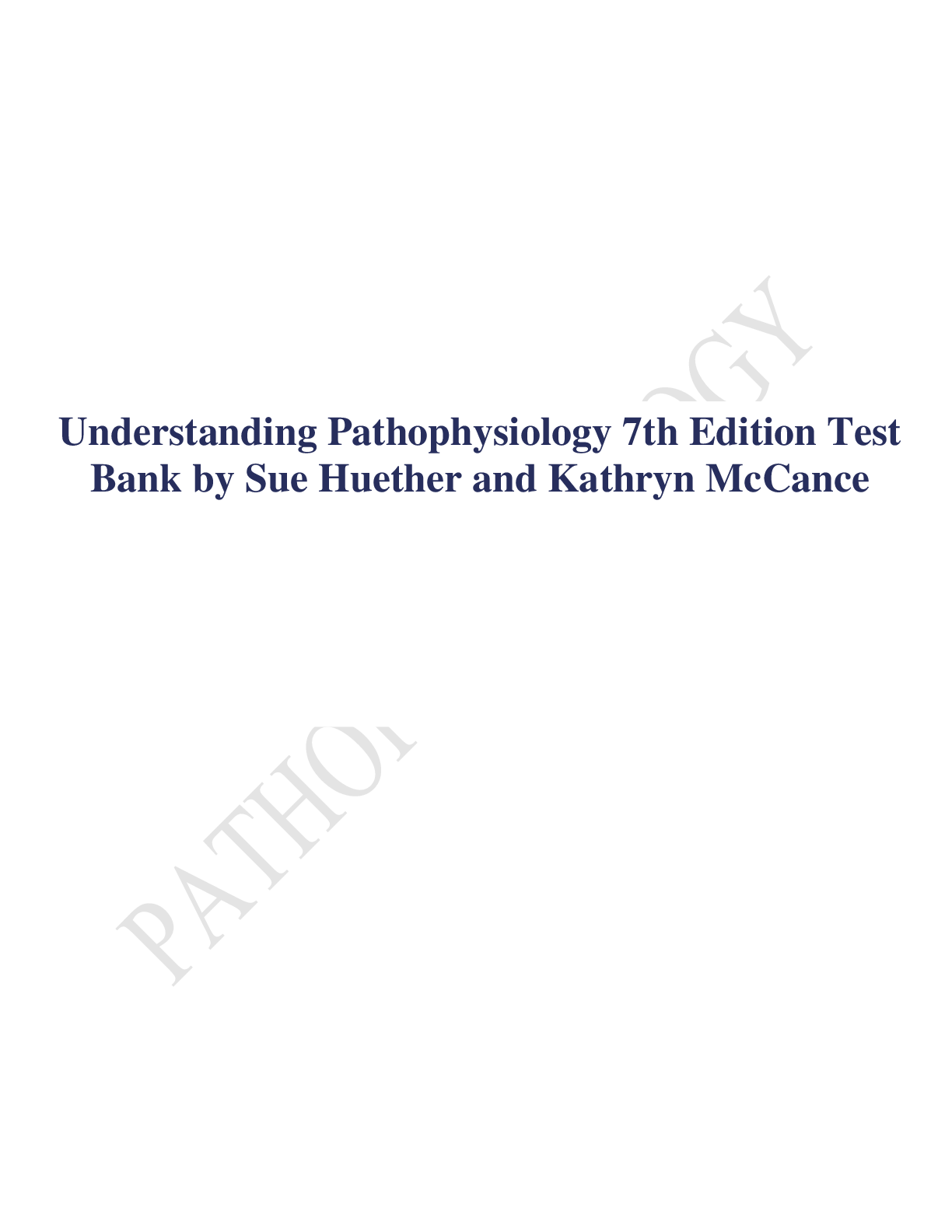*NURSING > TEST BANK > Test Bank Infection and Defects in Mechanisms of Defense Huether: Understanding Pathophysiology, 7th (All)
Test Bank Infection and Defects in Mechanisms of Defense Huether: Understanding Pathophysiology, 7th Edition
Document Content and Description Below
Test Bank Infection and Defects in Mechanisms of Defense Huether: Understanding Pathophysiology, 7th Edition MULTIPLE CHOICE 1. An immunologist is discussing endotoxin production. Which inform... ation should the immunologist include? Endotoxins are produced by: a. gram-negative bacteria. b. gram-positive bacteria. c. gram-negative fungi. d. gram-positive fungi. ANS: A Endotoxins are produced by gram-negative bacteria. They are not produced by gram-positive bacteria or any type of fungi. 2. A 5-year-old male becomes ill with a severe cough. Histologic examination reveals a bacterial infection, and further laboratory testing reveals cell membrane damage and decreased protein synthesis. Which of the following is the most likely cause of this illness? a. Endotoxin b. Exotoxin c. Hemolysis d. Septicemia ANS: B Exotoxins are enzymes that can damage the plasma membranes of host cells or can inactivate enzymes critical to protein syNntUhResSisI, aNnGdKenIdNoGto.xiCnOs aMctivate the inflammatory response and produce fever. Endotoxins released by blood-borne bacteria cause the release of vasoactive enzymes that increase the permeability of blood vessels. Hemolysis is the breakdown of red cells. Septicemia is the growth of bacteria in the blood. 3. A 50-year-old female experiences decreased blood pressure, decreased oxygen delivery, cardiovascular shock, and subsequent death. A complication of endotoxic shock is suspected. Which of the following is the most likely cause? a. Gram-positive bacteria b. Fungi c. Gram-negative bacteria d. Virus ANS: C Symptoms of gram-negative septic shock are produced by endotoxins. Once in the blood, endotoxins cause the release of vasoactive peptides and cytokines that affect blood vessels, producing vasodilation, which reduces blood pressure, causes decreased oxygen delivery, and produces subsequent cardiovascular shock. Gram-positive bacteria nor fungi do not produce endotoxins and thus do not manifest in shock. Viruses do not produce symptoms of shock. 4. After studying about viruses, which information indicates the student has a good understanding of viruses? Viruses: a. contain no DNA or RNA. b. are capable of independent reproduction. c. replicate their genetic material inside host cells. d. are easily killed by antimicrobials. ANS: C Virus replication depends totally on the ability of the virus to infect a permissive host cell, a cell that cannot resist viral invasion and replication. Viruses contain both DNA and RNA, are incapable of independent reproduction, and cannot be killed by antimicrobials. 5. After studying about fungi, which information indicates a correct understanding of fungi? Fungi causing deep or systemic infections: a. are easily treated with penicillin. b. are extremely rare. c. never occur with other infections. d. are commonly opportunistic. ANS: D Diseases caused by fungi are called mycoses. Mycoses are common and can be opportunistic and occur with other infections but are not treatable with penicillin. 6. Which information indicates a correct understanding of viral vaccines? Most viral vaccines contain: a. active viruses. b. attenuated viruses. c. killed viruses. d. viral toxins. ANS: B Viral vaccines contain live viNruUseRsSthIaNt aGrKe IwNeaGk.enCeOd M(attenuated). Viral vaccines do not contain active viruses, killed viruses, or toxins. 7. Which information indicates a good understanding of bacterial vaccines? Most bacterial vaccines contain: a. fully active bacteria. b. synthetic bacteria. c. dead bacteria. d. bacterial toxins. ANS: C Vaccines are biologic preparations of weakened or dead pathogens that when administered stimulate production of antibodies or cellular immunity against the pathogen without causing disease. Vaccines are not fully active bacteria, nor are they synthetic or toxins. 8. A nurse recalls bacteria become resistant to antimicrobials by: a. proliferation. b. attenuation. c. specialization. d. plasmid exchange. ANS: D Antibiotic resistance is usually a result of genetic mutations that can be transmitted directly to neighboring microorganisms by plasmid exchange. Antibiotic resistance is not a result of proliferation, attenuation, or specialization. 9. What common symptom should be assessed in individuals with immunodeficiency? a. Anemia b. Recurrent infections c. Hypersensitivity d. Autoantibody production ANS: B The clinical hallmark of immunodeficiency is a propensity to unusual or recurrent severe infections. The type of infection usually reflects the immune system defect. Neither anemia, autoantibody production, nor hypersensitivity is a manifestation of immunodeficiency. 10. When the immunologist says that pathogens possess infectivity, what is the immunologist explaining? Infectivity allows pathogens to: a. spread from one individual to others and cause disease. b. induce an immune response. c. invade and multiply in the host. d. damage tissue. ANS: C Infectivity is the ability of the pathogen to invade and multiply in the host. Communication is the ability to spread from one individual to others and cause disease. Immunogenicity is the ability of pathogens to induce an immune response. Damaging tissues is the pathogen’s mechanism of action. 11. When the immunologist says that pathogens possess virulence, what does virulence mean? a. Spreads from one individual to others and causes disease. b. Induces an immune respoNnsUeR. SINGKING.COM c. Causes disease. d. Damages tissue. ANS: C Virulence is the capacity of a pathogen to cause severe disease—for example, measles virus is of low virulence; rabies virus is highly virulent. Communication is the ability to spread from one individual to others and cause disease. Immunogenicity is the ability of pathogens to induce an immune response. Damaging tissues is the pathogen’s mechanism of action. [Show More]
Last updated: 1 year ago
Preview 1 out of 5 pages

Reviews( 0 )
Document information
Connected school, study & course
About the document
Uploaded On
Nov 06, 2021
Number of pages
5
Written in
Additional information
This document has been written for:
Uploaded
Nov 06, 2021
Downloads
0
Views
70










